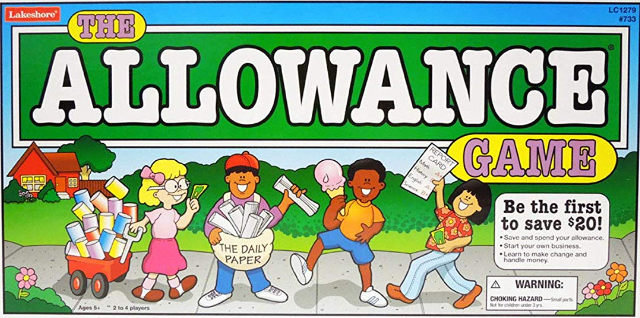 |
the Allowance Game |
Advance around the Allowance game board, getting familiar with the terms earning, saving and spending. Spaces
say things like "Walk the dog - Earn 50 cents" or "Go to the movies -
Spend $2.50". Collect $3 each time you pass Home.
The first player to save $20 is the winner. There are no decisions to make, so the first one to save $20 will depend solely upon the throw of the die. I bought this game
brand new and sealed, but no instructions were included in the box, so I can't give you the specifics of game play and I
don't know what the small chips are for.
To see a list of games with money, click here.
Try this:
- Sort the coins into the 5 cent, 10 cent, and 25 cents, spaces on the board before the game.
- Cup the hand and shake the die for 10 seconds before throwing it.
- Pick up (or put) several coins in the hand for sorting. Bring one coin at a time to the fingertips to drop.
- Skip the game. Line up the coins on the table with the face side up by putting one or more coins at a time in the players palm (or a couple coins at the base of the fingers). Ask him to move coins, one at a time, to the finger tips, turn them to the correct side, and place them on the table.
- Put the game away by picking up one coin at a time and squirreling it in the palm without dropping. Drop coins into the box by the handful. How many can you hold?
- Make change for $1. See how many different ways you can do it. When you get to $1, lay the money on a $1 bill. Repeat. See how many $1 bills you can count change for before the bank runs out of change.
- Pick up the coins one at a time as you count and squirrel them into the palm without dropping.
- Place 10 coins in a line on the table. Flip them one at a time so that they are face-down. Time yourself, do it again, and try to beat the time.
- Ask the player to cup one or two hands and hold them while you drop coins into the hand(s) one at a time while counting them, either by the piece or by the value.
- Work
on recognizing coins and bills, counting money, making change, manual
dexterity, in-hand manipulation, visual discrimination, socialization
skills, process skills, executive functioning skills, play and leisure exploration and participation
Ages 6+, 2-4 players



No comments:
Post a Comment
Thank you for taking the time to comment.